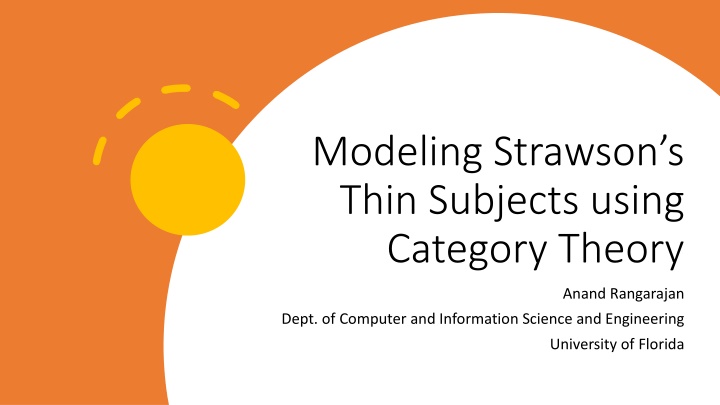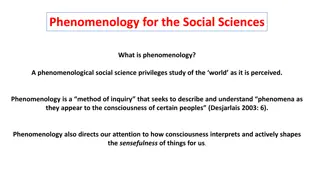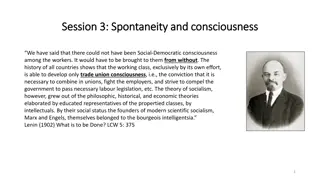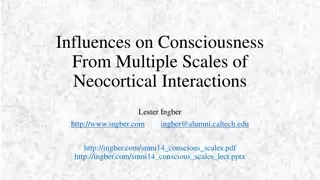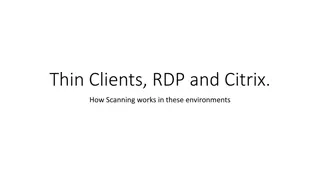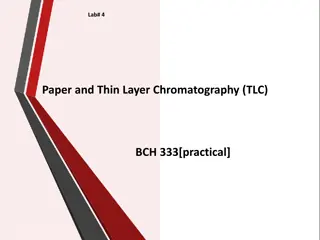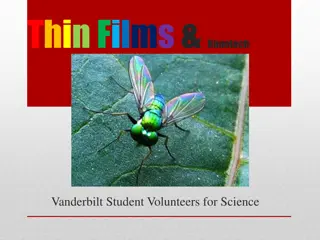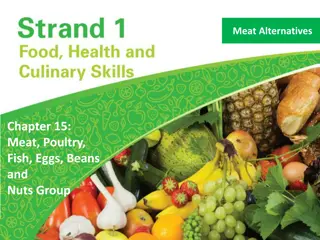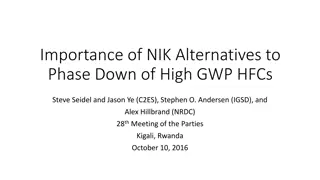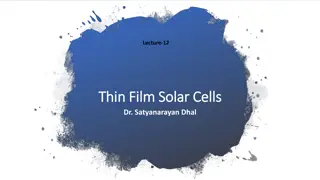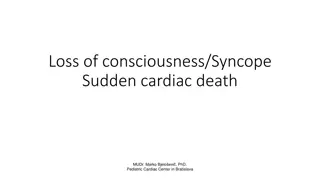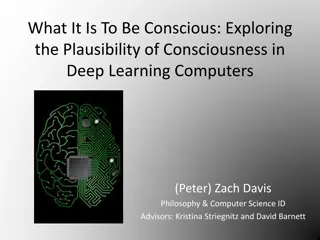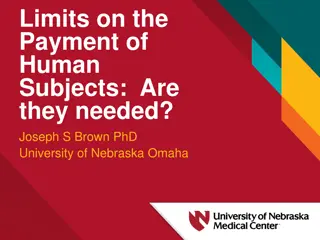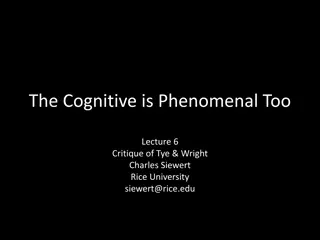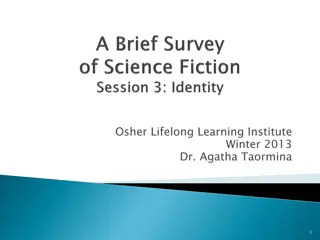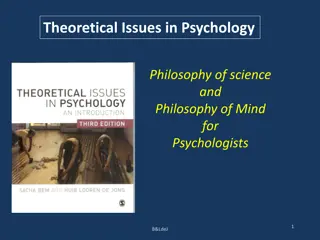Strawson's Thin Subjects in Consciousness: Exploring Emergence and Alternatives
Exploring the concept of Strawson's Thin Subjects in consciousness through the lens of emergence and alternative theories such as Panpsychism, Neutral Monism, and Dual-aspect Theory. Delve into the debate on whether experience is always accompanied by a subject of experience and the challenges posed by this perspective. Consider the implications for understanding consciousness and the relationship between complex systems and particles.
Download Presentation

Please find below an Image/Link to download the presentation.
The content on the website is provided AS IS for your information and personal use only. It may not be sold, licensed, or shared on other websites without obtaining consent from the author.If you encounter any issues during the download, it is possible that the publisher has removed the file from their server.
You are allowed to download the files provided on this website for personal or commercial use, subject to the condition that they are used lawfully. All files are the property of their respective owners.
The content on the website is provided AS IS for your information and personal use only. It may not be sold, licensed, or shared on other websites without obtaining consent from the author.
E N D
Presentation Transcript
Modeling Strawsons Thin Subjects using Category Theory Anand Rangarajan Dept. of Computer and Information Science and Engineering University of Florida
The Hard Problem Why is anything accompanied by experience (Chalmers)? Mainstream response: Emergence Alternatives Structure and dynamics Information processing Neuronal dynamics Physicalism and Materialism Panpsychism (Rosenberg, Skrbina, Strawson) Dual aspect Theory (Atmanspacher) Neutral Monism (Banks) Idealism (Kastrup) Ignorance and physicalism (Stoljar, Montero) Self-organization Complexity Systems theory Confused with holism
Emergence Emergent properties as behavior of complex information processing systems Description Slogan Consciousness arises from complex systems Perspective Complex systems view of the world Problem Thresholds left unspecified for emergence of consciousness Application Most forms of AI, living systems, simulators etc.
Alternatives to Emergence Experience fades out as you go down in complexity (Pan proto- psychism, Pan proto-experientialism) Panpsychism Neutral Monism Dual-aspect theory Matter and mind are both derived from neutral entity Interiors all the way down, interior/exterior divide Matter and experience derived from unitary subject: Transcendental Idealism Idealism Holism Experience is a holistic property of nature
Our slogan: Complex AI systems are not accompanied by experience Age old distinction: systems versus particles (back to 19th century atomism) Systems: Capable of complex information processing Particles: Highly unified and spatiotemporally bounded Systems: Wrong way of thinking about consciousness Intuition: Connection between radically unified experience and particles? Strawson s thin subjects highly suggestive Systems versus Particles
Claim: Experience always accompanied by subject of experience (SoE) Controversial Thin subject of experience: Strawson s alternative to Cartesian thick subjects Momentary Spatio-temporally bounded Grounding intuition: Experience feels unitary as if happening to one subject Criticism: Doubling of mysteries experience and SoE Strawson s response: Akin to objects (subjects) and properties (experience) The Crazy Hypothesis: Thin subjects are like particles (but of a very new kind) Thin Subjects (Strawson)
SoE more akin to a particle than a system (crazy hypothesis) Natural rather than artifactual or cultural Bid goodbye to the 19th century: Particles are formed in quantum field theory (QFT) via second quantization SoEs are special selfons accompanied by experience (Rangarajan) Second quantization in QFT creates selfons from basic fields But second quantization is a functor (as in category theory pointed out by Edward Nelson)! Can we model SoEs (or selfons) using category theory? Generalize from QM, QFT and move to modeling using category theory Thin Subjects, the Physical and Selfons
The story so far Why is anything accompanied by experience? Emergence hypothesis: Experience emerges in a sufficiently complex system Unworkable. Complex AI systems not accompanied by experience Particle thinking: Age old alternative to systems thinking Intuition: Link between unitary nature of experience and unity of particle Strawson: Unitary nature of experience because of thin subjects Thin subjects are akin to new particles (crazy hypothesis): selfons Particles are set up via second quantization in QFT: waves act like particles Second quantization is a functor as in category theory
id? Category Theory: Basics id? ? ? ? ? Definition: A category ? has constituents: 1. Objects: A collection Ob(?), elements called objects 2. Morphisms: For every pair ?,? Ob ? a set of morphisms ?:? ? from ? to ? 3. Identity: For every object ? Ob(?) an identity morphism id? on ? 4. Composition: For every three objects ?,?,? Ob ? , if ?:? ?, ?:? ? and :? ? then = ? ?:? ? Intuition: Morphisms are the glue relating objects Composition formula: Transitivity in object relations Relevance to HP: Selfons as objects (accompanied by experience) and intersubjectivity as evidence of morphisms id? ?
id? ? ? id? ? Category Theory: Functors ? Relating categories to each other Definition: If ? and ? are categories, a functor A. Associates to each object ? in ?, an object (?) in ? B. Associates to each morphism ?:? ?, a morphism ? : ? (?) Following conditions must hold: id? = id (?) and ? ? = ? (?) where ?,? are morphisms Intuition: Functors map objects and morphisms from one category to another Relevance to physics: Second quantization is a functor Relevance to HP: Map basic physical objects and transformations to selfons and intersubjectivity respectively id (?) (?) id (?) (?) (?) ?
Selfons as a Category id? id? ? ? Selfons ? as objects in a category Morphisms map thin subjects onto each other Intersubjectivity as the grounding intuition There but for the grace of god go I ?:Alice42 Bob108 Composition: If ?:Alice42 Bob108 and ?:Bob108 Charlie23, then = ? ?:Alice42 Charlie23 Set up a physical category ? Functors :? ? and :? ?need not be inverses. Selfons may impose further constraints in configuration space (Rosenberg) Importance of configuration space highlights tie to QFT ? ? ?:Alice42 ?:Bob108 ?:Charlie23 id? ? id (?) (?) ? ? id (?) (?) (?) ? ? (?) ? ? ? ? id? id? ? ?
Categories need not be equivalent Functors can exist between non-equivalent categories Brains Thin subjects Functor from the physical to the category of brain states Functor from the physical to selfons Equivalent categories Non-equivalent categories Information processing in brains: a convenient shorthand Selfons can enact constraints restricting sets of possibilities Natural fit: phase space dynamics Natural fit: configuration space dynamics
The major advance in QM: From Poisson manifolds and Poisson maps to Hilbert spaces and unitary operators From phase space to configuration space Particles act like waves The major advance in QFT: Particles are now seen as excitations of quantum fields From Hilbert space to Fock space: Second quantization Waves act like particles An advance due to Category Theory? Generalizes second quantization From sets and relations to objects and morphisms SoEs modeled as objects in a selfon category QM, QFT and Category Theory
Complex AI systems are not accompanied by experience Particle thinking alternative to systems thinking Unity of particle similar to unitary nature of experience Thin subjects of experience (Strawson): unified, spatiotemporally bounded Thin subjects are akin to new particles - selfons: crazy hypothesis Particles set up via second quantization in quantum field theory Second quantization is a functor (category theory)! Model thin subjects using category theory Brain state category equivalent to physical category Selfons may not be equivalent to the physical Conclusions
References 1. Dual-aspect Monism la Pauli and Jung, Harald Atmanspacher, J. Conscious Studies, 19(9-10):96-120, 2012. 2. The Conscious Mind: In Search of a Fundamental Theory, David J. Chalmers, Oxford University Press, 1996. 3. The Structure of Objects, Kathrin Koslicki, Oxford University Press, 2008. 4. The Ultimate Constituents of the Material World: In Search of an Ontology for Fundamental Physics, Meinard Kuhlmann, Ontos Verlag, 2010 5. Natural Kinds and Conceptual Change, Joseph LaPorte, Cambridge University Press, 2004. 6. Subjects of Experience, Edward J. Lowe, Cambridge University Press, 1996. 7. Can a Quantum Field Theory Ontology help resolve the Problem of Consciousness, Anand Rangarajan, Quantum Reality and Theory of nya, Springer Nature, pp. 13-26, 2019. 8. A Place For Consciousness: Probing the Deep Structure of the Natural World, Gregg Rosenberg, Oxford Univ. Press, 2004. 9. Quantum Field Theory and the Standard Model, Matthew D. Schwartz, Cambridge Univ. Press, 2013 10. Category Theory for the Sciences, David I. Spivak, The MIT Press, 2014. 11. Ignorance and Imagination: The Epistemic Origin of the Problem of Consciousness, Daniel Stoljar, Oxford University Press, 2006. 12. Physicalism, Daniel Stoljar, Routledge, 2010. 13. Selves: An Essay in Revisionary Metaphysics, Galen Strawson, Clarendon Press, 2009. 14. Material Beings, Peter van Inwagen, Cornell University Press, 1990.
Contact information: Prof. Anand Rangarajan Department of Computer and Information Science and Engineering University of Florida E-mail: anandr@ufl.edu
